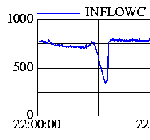

| Air Sampling from Aircraft |
David C. Rogers
Scientist |
This page shows examples of data from the NCAR C-130 for selected parts of a case study flight on May 18, 1998 near the SHEBA ice camp. They illustrate the the effects of riming on the performance of the anti-iced "small community" inlet that was used to bring ambient air to instruments inside the aircraft.
 The aircraft was penetrating a shallow low level stratus cloud 200-450m
AGL (HGM232) under a strong inversion. In the cloud, supercooled liquid
water (SLW) of ~0.1 to 0.2 g m-3 was measured
(PLWCC1) at -5 to -12°C (ATX). While the aircraft was in
cloud, rime ice built up on the sample inlet and choked off the air
flow. Upon leaving cloud, the ice melted or broke off, and the sample
flow was restored within ~30s. As long as the aircraft remained in the
supercooled water cloud, the sample air flow decreased
progressively. Faster decreases were associated with greater LWC
(click to see plot) .
The aircraft was penetrating a shallow low level stratus cloud 200-450m
AGL (HGM232) under a strong inversion. In the cloud, supercooled liquid
water (SLW) of ~0.1 to 0.2 g m-3 was measured
(PLWCC1) at -5 to -12°C (ATX). While the aircraft was in
cloud, rime ice built up on the sample inlet and choked off the air
flow. Upon leaving cloud, the ice melted or broke off, and the sample
flow was restored within ~30s. As long as the aircraft remained in the
supercooled water cloud, the sample air flow decreased
progressively. Faster decreases were associated with greater LWC
(click to see plot) .
A close-up view of the first cloud penetration
(22:10)
shows the 30s delay before INFLOWC was affected and the recovery period
of ~30s. Another close-up view of a
longer penetration (22:57-23:04)
shows similar responses.
"Interstitial" inlets that did not ingest cloud particles were also installed on the C-130. They were basically 1/4" tubes flush-mounted to the skin of the airplane. The anti-iced small community inlet was the preferable one for air sampling, but when problems with riming were recognized, the "interstitial" sample inlet was used. The interstitial inlet had other problems (not discussed here).
Although the PMS 2D-c probe showed only ~0.5 particles per liter, the CPI probe showed much higher values, ~50/L. A large fraction of the CPI images were circular and up to 100µm in diameter, suggesting supercooled drizzle drops. If so, the characteristics of icing may not be adequately represented as due to the LWC in 20µm cloud droplets.
--end--
This material is based upon work supported by the National Science Foundation
under Grant No. ATM97-14177 and by NASA grant NAG1-2063. Any opinions,
findings, and conclusions or recommendations expressed in this material
are those of the author(s) and do not necessarily reflect the views of
the National Science Foundation.
Back to Arctic